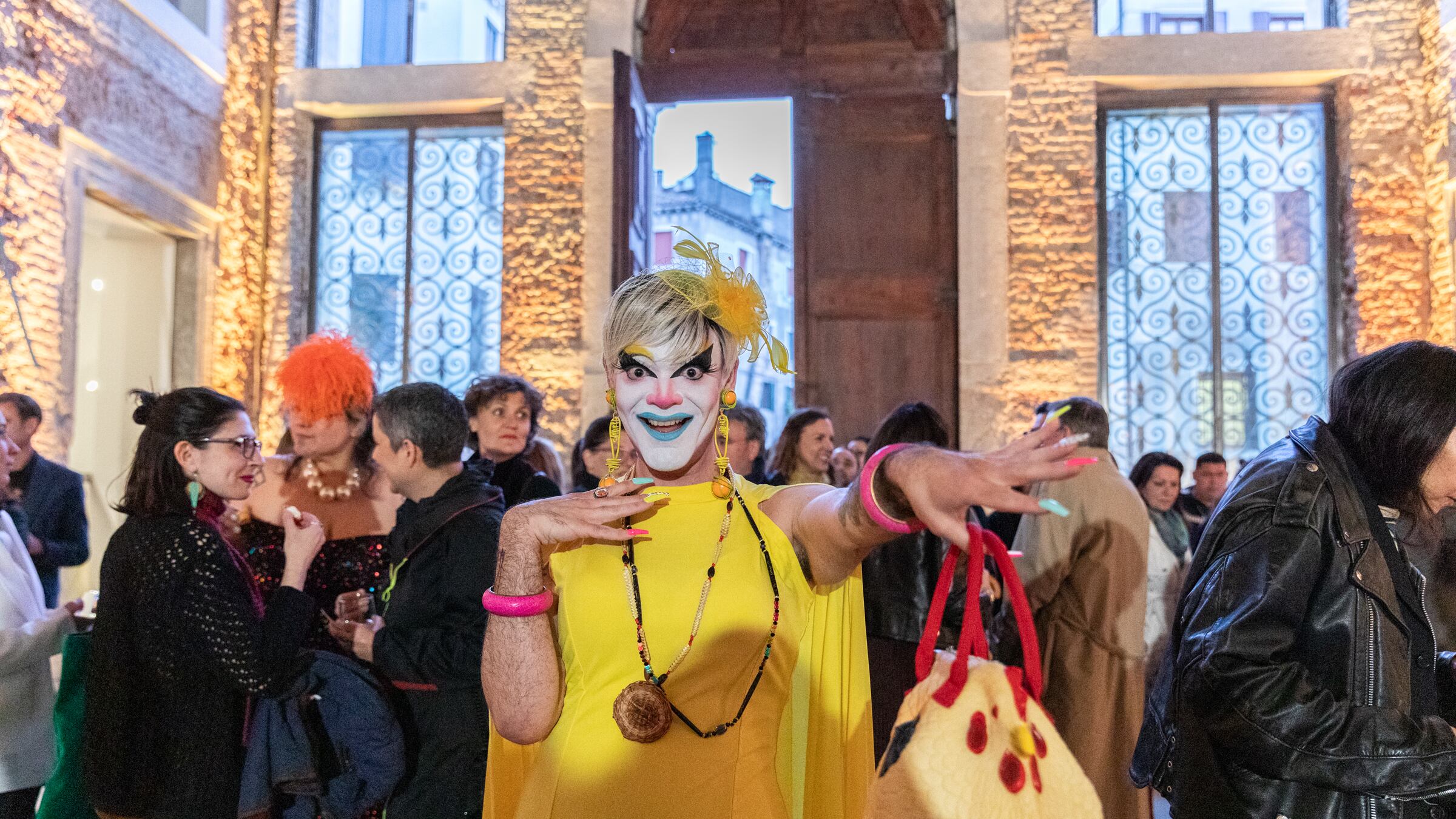Anthony Hudson loves unleashing their drag clown persona, Carla Rossi. Even though it’s been years since Hudson performed in a bar, they still get offers to take Rossi to typical drag gigs, like brunch. They still love hosting their Hollywood Theatre screening series like Queer Horror on Friday, May 31.
But last month, Hudson got a taste of life on a bigger stage. They say whoever books their next gig needs to pay more cheese than a Sizzle Pie pizza.
“Everyone thinks, like in the film To Wong Foo, that I just want to live in drag and all I want to do is host bingo for free,” Hudson half jokes. “While that could be true, depending on who’s asking, I was like, ‘After you send Mama to host events at the most prestigious art event in the world, I’m sorry, the rates are going up.’”
Hudson/Rossi, a Grand Ronde tribal member and Siletz descendant, performed as a guest artist and emcee for New York artist Jeffrey Gibson’s installation in Venice Biennale’s U.S. Pavilion in April. Hudson as Rossi stood out among an impressive assemblage of some of the finest living Native American artists.
The Venice Biennale is one of the global art world’s most prestigious gatherings, drawing artists and patrons from across the planet every two years since 1895.
“As a weird, poor kid from Keizer, Oregon, I didn’t even know what the Venice Biennale was until I was at PNCA, and even then I didn’t know how to say ‘biennale,’” Hudson says. “It was life changing, and it is something I still can’t believe happened. It was the best week of my life, in terms of my ‘living my life’ life and my professional life, my career. It felt like the pinnacle.”
Gibson’s exhibition, the space in which to place me, is the first show by a Native American artist to represent America in Venice in nearly a century. Indigenous artists showed work in Venice back in 1932, but their inclusion, though popular at the time, was nearly erased from historic memory.
Gibson’s artistry, famed for its bold use of color as well as its multidisciplinary focus, is celebrated for the different means he employs to make his audience reconsider what they know about Native American art and history. Hudson’s inclusion in Gibson’s collaborative cast of all-Indigenous artists, including some of North America’s premier jingle dancers, was a secret up to the Biennale’s opening in April.
Gibson and Hudson first met at his PAM exhibition in 2022. He hired Rossi for Venice after seeing how Hudson talked in character to children in the museum.
“I go into these situations, even here in Portland, where I just feel like the weird kid trying to do something strange and artsy and funny, and I challenged myself to do that going into the Biennale because I was like, ‘Jeffrey wants me because he has seen me be myself,’ so I just challenged myself to be myself and not be anything else,” Hudson says.
Hudson pulled tricks from their repertoire familiar to Portland fans, but virtually unknown to the Biennale’s audience, like original theater and pop culture cosplay. Hudson performed with poet Layli Long Soldier and musician/artist Laura Ortman. Hudson/Rossi and Long Soldier later acted out a session of Hudson’s therapy-themed show, Ask Dr. Carla —which WW previewed in February—on Gibson’s platform sculpture of vivid red Grecian columns in the pavilion’s courtyard.
Hudson returned on their day off for an unofficial activation, which was their most viewed appearance on social media. (Art activations are gallery-speak for when an artist engages another artist’s work in a way that draws out additional meaning for the audience.)
Hudson dressed as Tomb Raider character Lara Croft with Rossi clown face, to scale Gibson’s columns, moving robotically, mimicking how early video game characters moved, and accidentally fell off the platform. Hudson says they weren’t hurt. Their drag padding “air bag” shielded them from possibly worse injuries.
The performance was both a commentary on the treatment of Indigenous art and bodies in archeology; and a simple homage to Tomb Raider 2′s Venice level.
“I was thinking about the British Museum, how there’s no accountability for other colonizers in the Old World that just have our bones and our ancestors and our relics,” Hudson says. “But I was also like, ‘Girl, I love [Lara Croft]. I’m going to fall off this sculpture just like she did.’ I didn’t plan to fall off the sculpture, but in hindsight, it was the most iconic thing I could do.”
Hudson/Rossi emceed a dinner held to honor Gibson and the Biennale’s patrons. Hudson packed their monologue with homages to the most obviously low-brow Italian-American cultural references, from the Super Mario Brothers to Olive Garden and Chef Boyardee. Hudson said their monologue went over better than they expected, with cadres of Italian men later calling out “bella, bella,” to them. At this dinner, Hudson spoke in support of Palestine amid the ongoing Israel-Gaza War, amid protests and snide comments against the U.S. and Israeli Pavilions.
Hudson’s favorite official Biennale duty was hosting a dance party in a historic fish market with their family—and legendary underground DJ Honey Dijon, who just wrapped up working with Beyonce and Madonna. Though Hudson has attended large Native American social gatherings like powwows, they say the fish market dance party was unlike anything they’ve ever experienced.
“I was in Venice, at the biggest, most prestigious art event in the world, but in Jeffrey’s space I felt like I was in an Indigi-queer nightclub, and I’ve never experienced that before, ever,” Hudson says. “We get the pain narrative, we get the trauma narrative, we get the colonization narrative, but what Jeffrey gave us was a celebratory queer narrative, and that’s shockingly unheard of.”
See more photos from Hudson/Rossi’s Biennale experience below.
0 of 7







